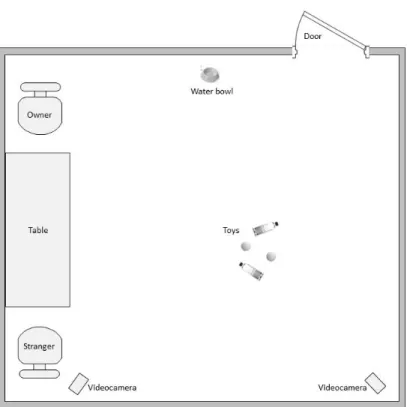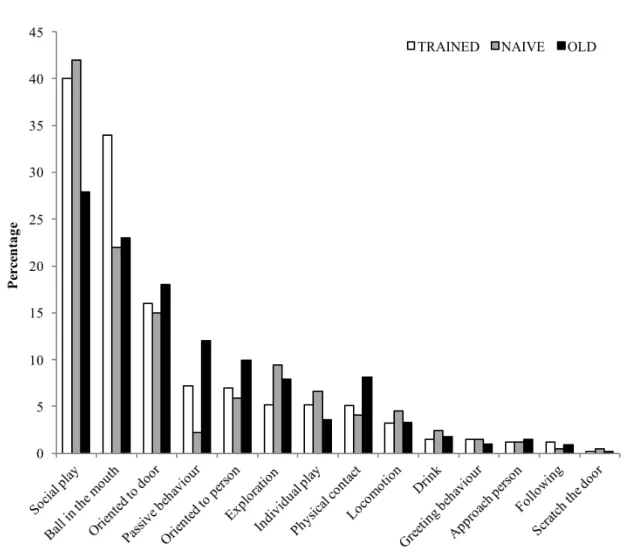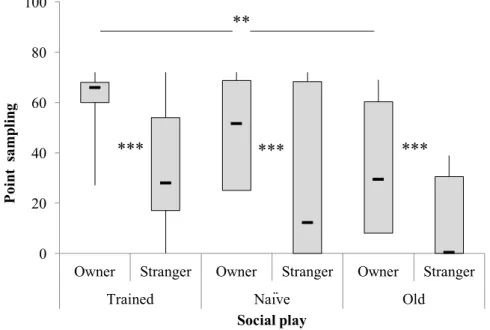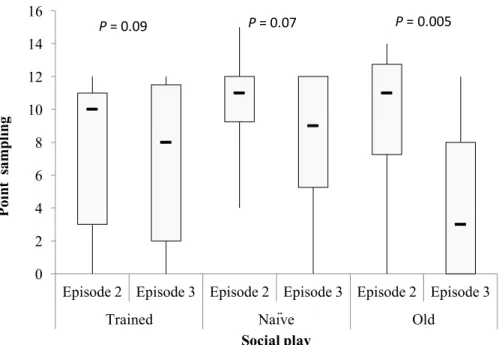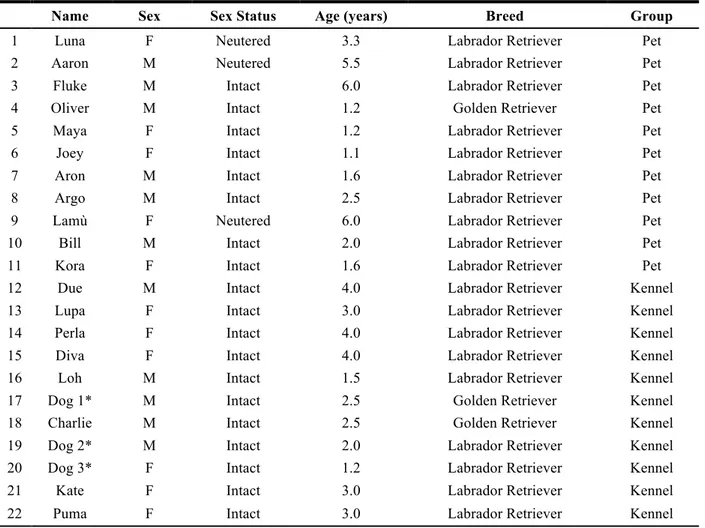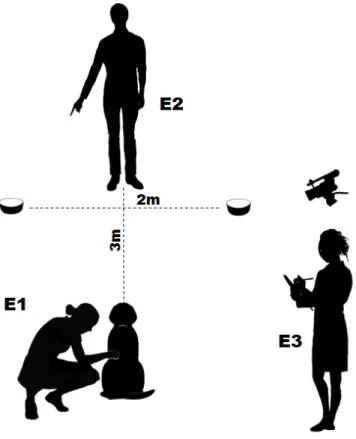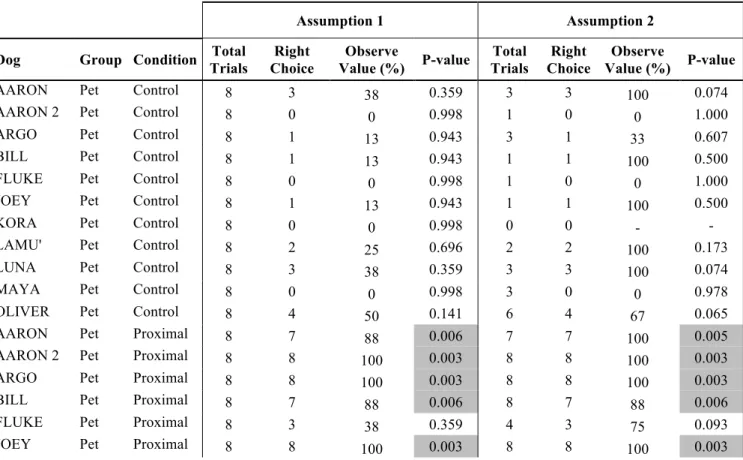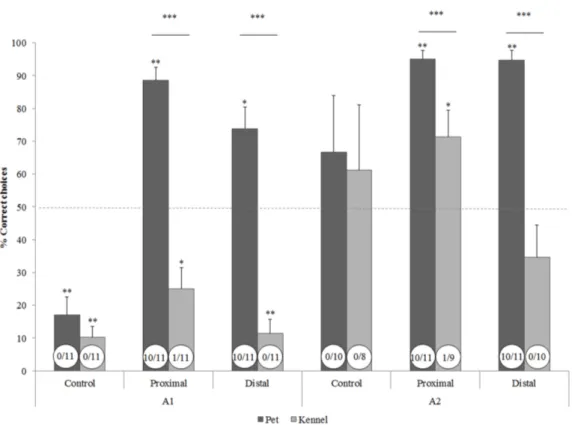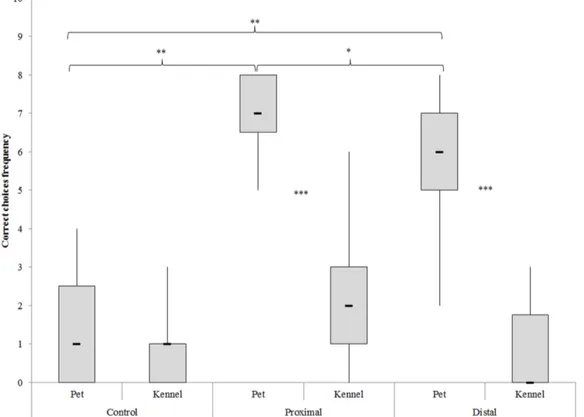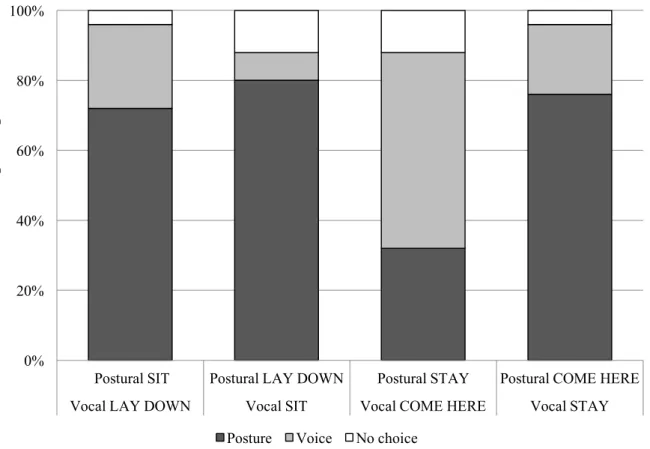U
NIVERSITÀ DEGLI
S
TUDI DI
N
APOLI
“F
EDERICO
II”
SCUOLA
POLITECNICA
E
DELLE
SCIENZE
DI
BASE
AREA
DIDATTICA
SCIENZE
MM.
FF.
NN.
T
HE EVOLUTION OF HUMAN
-
DOG COMMUNICATION
MECHANISMS DURING THE DOMESTICATION
PROCESS
T
ESI DID
OTTORATO INB
IOLOGIAXXXICICLO
T
UTORD
OTTORANDAC
H.
MOP
ROF.
D
OTT.S
SAB
IAGIOD’A
NIELLOA
LESSANDRAA
LTERISIOCHAPTER 1:BACKGROUND 1
1.1How domestication is defined 2
1.2 The domestication syndrome 3
1.3References 9
CHAPTER 2:THE AIMS 14
2.1Quality exposure level on dog-human bond 16
2.2 Quantity exposure level on dog’s comprehension of human gestures 17
2.3 The importance of visual message during the typical human communication 18
2.4 The unexplored olfactory communication 20
2.5 An overview on dog’s sex difference: is it a consequence of domestication? 21
2.6 References 21
CHAPTER 3:BEHAVIOURAL EFFECTS OF TRAINING ON WATER RESCUE DOGS IN THE STRANGE
SITUATION TEST 29
3.1Introduction 30
3.2 Materials and methods 32
3.2.1 Subjects 32
3.2.2 Experimental design 33
3.2.3 Data collection and analysis 35
3.3 Results 37
3.3.1 Social play behavior 38
3.3.2 Ball in the mouth 40
3.3.3 Orientation towards the door 41
3.3.4 Passive behavior 41
3.3.5 Orientation to the person 41
3.3.6 Exploration 42
3.3.7 Individual play 42
3.3.8 Greeting behavior 43
3.4 Discussion 43
3.5 References 46
CHAPTER 4:WHAT'S THE POINT?GOLDEN AND LABRADOR RETRIEVERS LIVING IN KENNELS DO NOT
UNDERSTAND HUMAN POINTING GESTURES 49
4.1Introduction 50
4.2 Materials and methods 53
4.2.3 Procedure 56
4.2.4 Scoring and data analysis 57
4.3 Results 58
4.4 Discussion 62
4.5 References 65
CHAPTER 5:THE IMPORTANCE OF GESTURAL COMMUNICATION: A STUDY OF HUMAN-DOG
COMMUNICATION USING INCONGRUENT INFORMATION 69
5.1Introduction 70
5.2 Materials and methods 71
5.2.1 Participants 71
5.2.2 Experimental procedure 71
5.2.3 Data scoring 73
5.2.4 Data analysis 73
5.3 Results and Discussion 74
5.4 References 77
CHAPTER 6:EFFECTIVENESS OF VERBAL AND GESTURAL SIGNALS AND FAMILIARITY WITH
SIGNAL-SENDERS ON THE PERFORMANCE OF WORKING DOGS 79
6.1Introduction 80
6.2 Materials and methods 83
6.2.1 Participants 83
6.2.2 Experimental procedure 83
6.2.3 Data collection and analysis 85
6.3 Results 87
6.4 Discussion 91
6.5 References 94
CHAPTER 7:SHOULD I FETCH ONE OR THE OTHER?A STUDY ON DOGS ON THE OBJECT CHOICE IN
THE BIMODAL CONTRASTING PARADIGM 98
7.1Introduction 99
7.2 Materials and methods 102
7.2.1 Participants 102
7.2.2 Procedure 102
7.2.3 Data scoring and analysis 105
7.3 Results 106
CHAPTER 8:INTERSPECIES TRANSMISSION OF EMOTIONAL INFORMATION VIA CHEMOSIGNALS: FROM
HUMANS TO DOGS (CANIS LUPUS FAMILIARIS) 115
8.1Introduction 116
8.2 Materials and methods 119
8.2.1 Odor collection 119
8.2.2 Subjects 120
8.2.3 Apparatus and procedure 120
8.2.4 Behavioral parameters 121
8.2.5 Heart rate monitoring 122
8.2.6 Data analysis 123
8.3 Results 123
8.3.1 Linear discriminant analysis (LDA) 123
8.3.2 Temporal unfolding 126
8.3.2.1 Owner directed behaviors 126
8.3.2.2 Stranger directed behavior 126
8.3.2.3 Apparatus directed behavior 127
8.3.2.4 Stressful behaviors 127
8.3.2.5 Heart rate monitoring 130
8.4 Discussion 130
8.5 References 133
CHAPTER 9:BEHAVIORAL AND PERCEPTUAL DIFFERENCES BETWEEN SEXES IN DOGS:
AN OVERVIEW 140
9.1Introduction 141
9.2 Personality traits 143
9.2.1 Aggressiveness 143
9.2.2 Boldness and courage 146
9.2.3 Sociability 149 9.3 Cognitive processes 151 9.3.1 Spatial cognition 151 9.3.2 Lateralization 153 9.4 Perception 155 9.4.1 Visual focusing 155 9.4.2 Olfactory skills 156 9.5 Discussion 157 9.6 Future directions 160
CHAPTER 10:CONCLUSIONS 177
C
HAPTER
1
B
ACKGROUND
Animals have always played an important role in the lives of humans, such that, over the past 11,000 years, they have been brought under domestication in every part of the world. Domestic animals belong to mammals, birds, reptiles, amphibians, fish, insects, and even bacteria. Raised for food, secondary products, labor and companionship, domestic animals merged into human society (Alves, 2016). Although the principal motivation for the domestication of most species was their potential to furnish products consumed as food by humans (Diamond, 2002; Muller, 2002; Russell, 2002), the very first domestication was apparently not associated with this intention. It seems that the first domesticated animal was the ancestor of the nowadays wolf, giving rise to domesticated dogs (Canis lupus
familiaris) (Muller, 2002). These animals were probably useful as guards and in helping humans
during their hunting activities (Muller, 2002), roles which they still fulfill today (Koster, 2008). Later, other mammals were also domesticated, such as cattle, sheep, goats, pigs, horses, donkeys.
The degree to which a wild population of animals is willing to domestication largely depends on the degree of developmental plasticity of the species and the extent to which the captive environment, compatible with husbandry techniques, allows the expression of species-typical behavioral patterns (Balon, 1995). Although there are many reported differences between wild and domestic stocks, there are little evidences that domestication has resulted in the loss of specific behaviors or that the basic
structure of the motor patterns for such behaviors has been changed (Scott and Fuller, 1965; Hale, 1969; Miller, 1977). The hypothesized loss of certain behavior under domestication can be explained, instead, by the heightening of response thresholds, changing in the quantitative rather than qualitative nature of response (e.g., fear reduction, increased stress tolerance, higher social tolerance).
1.1 How domestication is defined
Price and King (1968), with a very stringent definition, proposed that “domestication is an evolutionary process involving the genotypic adaptation of animals to the captive environment”, asserting that three different genetic processes influence populations of animals undergoing domestication: natural selection, artificial selection and relaxed selection. The first provides the basic selective mechanism for genetic change in captive populations; it is most intense during the first few generations (during the transition from field to captive environments), but it strength depends on the number of generations in captivity and how much the captive environment allows for the development and expression of species-typical biological characteristics (Spurway, 1955). The second one is the only selective mechanism unique to domestication, and it may be applied either intentionally or unconsciously by human with a selection for preferred traits. The relaxed selection is representative of the increase in both genetic and phenotypic variability for traits directly connected to behaviors essential for survival in nature, which lose much of their adaptive significance in captivity (e.g., food finding, predator avoidance).
Ratner and Boice (1975) were the first to give a more ontogenetic approach by acknowledging the contributions of both genetic change and experience separately in the development of the domestic phenotype. Price (1984) assumed that genes and developmental environment operate together to determine phenotypic outcomes.
Though, the experiential acquisitions are not transmitted to the next generation, so many researchers do not consider them in a formal definition of domestication. According to Kisling (2001), domestication was a long-term biological process that required the breeding of wild animals for many generations and was only fully accomplished when significant changes occurred in the behavior,
physical attributes, and genetics of the captive species. These alterations were presumably not triggered (or at least not initially) by human communities, leading us to imagine that domestication was not premeditated or predetermined.
1.2 The domestication syndrome
Once humans started agriculture, domestication and diversification of animals accelerated, such that they probably evolved traits that were adaptive under these new conditions (Jensen, 2014). Although each species has its own history, common denominators in terms of adaptation to life with humans have caused domestic populations to diverge rapidly from their wild ancestors in appearance, physiology, and behavior.
Some behavioral characteristics make certain animal taxa (and individuals), better candidates for domestication than others (Hale, 1969; Price, 1984, 1999, 2002; Zeder, 2012). The foremost prerequisites of successful domestication must have been a reduced fear and aggressiveness toward humans, enabling reproduction in conditions that would normally elicit strong stress reactions (e.g., confinement, human proximity, and crowding) and less territoriality and aggression toward conspecific, as a consequence of living in larger groups in overcrowded conditions (Forkman et al., 2007; Campler et al., 2009; Hughes and Mcdonald, 2013). Therefore, the low reactivity toward external stimuli is a central preadaptation for animal domestication, including all domesticated mammals — carnivores (Trut, 1999; Coppinger and Coppinger, 2001), herbivores (Tennessen and Hudson, 1981), and rodents (Murphy, 1985) — as well as domestic birds (Andersson et al., 2001), fish (Waples, 1991), and even domesticated invertebrate species (Marliave et al., 1993; Price, 2002).
Belyaev (1969), a Russian geneticist and academician, believed that the phenotypic changes observed in domesticated animals were regulated by a fine balance between neurotransmitters and hormones at the level of the whole organism. The genes that control that balance occupy a high level in the hierarchical system of the genome (i.e., a pleiotropic effect for which linked traits may arise from mutations in a few key regulatory genes; Jensen, 2006), whose main role is to control the functioning of the neural and endocrine systems, which also control animal’s behavior including its
friendliness/hostility towards humans. So, he claimed that the key factor for domestication was the selection of a peculiar behavior: tameness. According to this concept, selecting animals for behavioral traits could have fundamentally altered the development of an organism and could have been directly related to brain neurochemistry. Because mammals from widely different taxonomic groups share similar regulatory mechanisms for hormones and neurochemistry, it was reasonable to believe that selecting them for similar behavior (tameness) should alter those mechanisms, and the other developmental pathways they control, in similar ways.
To test his hypothesis, Belyaev designed a selective-breeding program (begun about 50 years ago at the Institute of Cytology and Genetics in Novosibirsk, Siberia) characterized by a strong selection pressure for tameness, choosing as experimental model a species taxonomically close to the dog but never domesticated: Vulpes vulpes, the silver fox (Belyaev, 1979; Trut, 1999). Tameness is an important behavioral trait since it facilitates animal handling (Grandin, 2007) and improves animal welfare (Hemsworth and Barnett, 1987). Acquired tameness can be achieved by habituation or positive associative conditioning. In habituation, the animal’s fear of humans is gradually reduced by repeated exposures in a neutral context (absence of positive/negative reinforcing by man’s presence), but it may also be achieved by positive associative conditioning with humans as secondary reinforcer (as providers of food, water, shelter, grooming or companionship). In this way, the threshold for avoidance behaviors is raised. However, acquired or learned tameness is not transmitted from mother to offspring. For example, the human avoidance by the offspring of hand-reared (tame) and mother-reared (relatively untamed) ungulates is very similar when exposed to people in the absence of their mother or herd-mates (Blaxter, 1974; Lyons et al., 1988a), whereas mother-reared dairy goats exhibited less avoidance of humans when accompanied by tame herd-mates (Lyons et al., 1988b). To ensure that tameness results came from genetic selection, Belyaev and his team avoided training, submitting the foxes to a battery of tests. When a pup was one month old, an experimenter offered it food from his hand while trying to stroke and handle it. The pups were tested twice, once in a cage and once while moving freely with other pups in an enclosure, where they could choose to make contact either with the human experimenter or with another pup. The test was repeated monthly until the pups were six or
seven months old. At seven or eight months, when the foxes reached sexual maturity, they were scored for tameness and assigned to a class. Foxes that were afraid of the experimenters or bit when stroked or handled, were assigned to Class III. Foxes in Class II let themselves be petted and handled, although not showing emotionally friendly response to experimenters. Foxes in Class I were friendly toward experimenters, wagging their tails and whining. Finally, the members of Class IE (after sixth generation), before they were one month old, already have started to be eager to establish human contact, whimpering to attract attention, sniffing and licking experimenters. The unselected control population continued to exhibit a wild-type behavior, including strong defensive responses toward humans. Corresponding to the hypotheses, years later Belyaev research group noted an increase of the corticosteroids in the blood plasma of the tamed foxes, which was the direct consequence of changes in the serotonin system, the leading mediator inhibiting animal’s aggressive behavior (Trut, 1999). Particularly, higher levels of serotonin, and of its metabolite 5-hy-droxyindole acetic acid, have been detected in the brain of tamed foxes (Popova et al., 1991). Other endocrinological changes associated with the domestication syndrome have been recognized, such as the reduction adrenocorticotropic hormone release from the anterior pituitary of the hypothalamic-pituitary-adrenal axis associated with the stress response in mammals (Gulevich et al., 2004; Trut et al., 2009; Hare et al., 2012; Wilkins et al., 2014).
Darwin (1868) was the first recognizing that domestic animals possess a wide variety of similar morphological traits despite the lack of close evolutionary relationships between their wild progenitors (herbivores and predators, large and small). This phenotypic convergence includes change in body size and proportions, leading to the appearance of dwarf and giant breeds; change in the typical wild coat camouflage in favor of a completely lacking pigmentation in specific body areas (piebald or spotted coat). The latter characteristic has some linkage with the biochemical pathways of melanin, involved in coat coloration, and neurotransmitters, such as the dopamine, which in turn affect the behavior and the cognition (Keeler et al., 1968; Hemmer, 1990). Hair turned wavy or curly, also becoming longer or shorter. Tails changed, too, curling up in a circle or semicircle, or shortening as a result of a decrease in the number of tail vertebrae. Ears became floppy, a feature not found in any wild animals, which
may be a byproduct of the neoteny (Fox, 1968; Morey, 1994, Goodwin et al., 1997; Fang et al., 2009). In many domesticated species, certain anatomical characteristics of the juvenile (e.g., shortening of the jaws and facial region) are retained into adulthood, perhaps to preserve the greater esthetic appeal of the young animal (Dechambre, 1949; Clutton-Brock, 1981; Morey, 1994). Coppinger and Smith (1983) suggest that behavioral neoteny together with a placid temperament (tameness) have been selected for in certain wild species (e.g., the ancestors of our common domestic animals) and are a prerequisite to successful domestication. The behavior of the dog provides the most compelling case of behavioral neoteny accompanying the domestication process. Comparative studies of domestic dogs and wolves (Fox, 1978; Frank and Frank, 1982; Ginsburg and Hiestand, 1992; Morey, 1994) have suggested that the behaviors of the adult dog are relatively juvenile compared to wolves. Neoteny may characterize the behavioral development of the dog because of selection for tractability, a trait frequently associated with juvenile animals. The ease with which most dogs can be trained to perform various tasks may reflect a high degree of plasticity relative to the more structured (i.e., less variable) adult-like behavior of their wild relatives. Coppinger et al. (1987) has pointed out that different dog breeds may express different degrees of behavioral neoteny. Dog breeds selected for herding livestock exhibit the eye/stalk/chase/and (sometimes) bite sequence of predatory behaviors but refrain from attack. Dog breeds selected for protecting livestock lack these predatory behaviors and will sometimes engage them (livestock) in play. An alternative to the selection hypothesis is that behavioral neoteny in domesticated animals may be environmentally induced. First, captive young animals may be conditioned to retain their juvenile behaviors. Offering positive rewards for juvenile behaviors (e.g., care-soliciting, playfulness, submissiveness to humans) may, in effect, retard the development of more independent adult activities, or alternatively, may reduce their expression. This latter effect could be achieved by raising the threshold for elicitation of adult behaviors or by sufficiently lowering the threshold for juvenile behaviors to allow for the continued expression of many juvenile characteristics throughout adulthood. Moreover, rearing animals in physical isolation from older, socially dominating conspecifics, may further discourage the development of normal adult-like patterns of agonistic behaviors (Price, 1978) and facilitate the retention of many juvenile social behaviors. Nevertheless, it
is interesting to underline how the dog’s sociability may be the result of the canine homologous Williams-Beuren syndrome (vonHoldt et al., 2017), a genetic disorder that in humans causes hyper-sociability (Dykens and Rosner, 1999). Indeed, a deletion in 5-Mb genomic region on chromosome 6 linked to the syndrome was observed in dogs but not in wolves (vonHoldt et al., 2017).
The neoteny was also responsible for changes in the dimensions of the skull (Wayne, 1986; Morey, 1992; Trut, 1999) and in a shortening of snout length which results in tooth crowding and a reduction in teeth number and size (Turnbull and Reed, 1974). This collection of traits has been termed as the domesticated phenotype (Price, 2002) and represents an animal equivalent of the domestication syndrome described in plants (Harlan, 1975). All these morphological characteristics have also been highlighted in domesticated foxes, so that Belyaev demonstrated that selection for tame behavior resulted in the acquisition of numerous other phenotypic traits including piebald coats, drooping ears, upturned/reduced tails, shortened snouts and under-bites, smallest legs, and shifts in developmental timing, as an effect of the domestication syndrome (Trut, 1999; Trut et al., 2009). A similar process was also observed in chickens (Agnvall et al., 2012).
It is also being observed that sustained and increasingly intensified selection for lowered reactivity resulted in profound changes in brain size in other animals (Plogmann and Kruska, 1990; Ebinger, 1995; Ebinger and Röhrs, 1995; Kruska, 1988, 1996; Rehkämper et al., 2008). As showed in lower vertebrates (Pinelli et al., 2014) changes in brain evolution can affect some areas in different manner. Accordingly, not all parts of the brain are equally affected by brain-size reduction in domesticated mammals, in which the most evident change is the reduction of the complex structures belonging to the limbic system, with domestic pigs, dogs, and sheep showing a greater than 40% reduction in size in comparison with their wild progenitors (Kruska, 1988). The limbic system, including the hippocampus, the hypothalamus, the pituitary gland, and the amygdala, regulates the endocrine functions and the autonomic nervous system activities linked to behaviors like aggression, wariness, and responses to environmentally induced stress. The reduction in the size of this portion of the brain in domesticated animals can be directly linked to an increase in the threshold reactivity for the display of behaviors such as aggression, fear, and flight (Kruska, 1988; Price, 2002). Although some
researchers characterize these changes as a “decline of environmental appreciation” (Hemmer, 1990) or even more negatively as “regressive evolution” (Röhrs, 1985), the higher threshold related to stressful situations in domestic animals be highly adaptive, leading to cope better with the stimuli in the anthropogenic niches (Price, 2002).
There is considerable support for the hypothesis that domestication has prolonged and accelerated some developmental processes by selective mechanisms (Cairns, 1976). Some of the differences have obvious links to the changes in animals’ social behavior, such as the extension of the sensitive period, essential for the socialization. In dogs, for example, it is well known that the first weeks of life are crucial for creating a primary social bond with humans through the imprinting. The "window" of bonding opens when a puppy becomes able to sense and explore its surroundings, and it closes when the pup starts to be afraid of unknown stimuli (from 8 to 12 weeks, depending on the breed). According to Belyaev team (1985; Trut, 1999), non-domesticated fox pups start responding to auditory stimuli on day 16 after birth, and their eyes are completely open by day 18 or 19. On average, the domesticated fox pups respond to sounds two days earlier and open their eyes a day earlier than their non-domesticated cousins. Non-non-domesticated foxes first show the fear response at 6 weeks of age, whereas domesticated ones show it after 9 weeks or even later. As a result, domesticated pups have more time to become imprinted to humans.
Other major evolutionary consequences of domestication are the accelerated attainment of sexual maturity, the loss of the seasonal rhythm of reproduction and the changes in mate preferences. There are evidences that most domestic dogs become sexually mature at 6 to 9 months of age, which is considerably earlier than for wolves and other wild canid species (Scott and Fuller, 1965; Fox, 1978). Moreover, most wild animals in middle latitudes are genetically programmed to mate once a year, whereas domestic animals at the same latitudes can mate more than once a year irrespectively from the season (Christie and Bell, 1971). Otherwise wolves are forced to breed only once a year mating in the winter months (Scott and Fuller, 1965). In addition, the monogamy or specific mate preferences of wild canids has been largely eliminated in domestic dogs, shifting toward more promiscuous sexual relations (Scott and Fuller, 1965).
1.3 References
Agnvall, B., Jöngren, M., Strandberg, E., & Jensen, P. (2012). Heritability and genetic correlations of fear-related behavior in red junglefowl–possible implications for early domestication. PloS one, 7(4), e35162.
Alves, R. R. N. (2016). Domestication of animals. In: Albuquerque, U.P., Alves R. (Eds.),
Introduction to Ethnobiology, (pp. 221-225). Springer, Cham.
Andersson, M., Nordin, E., & Jensen, P. (2001). Domestication effects on foraging strategies in fowl. Applied Animal Behavior Science, 72(1), 51-62.
Balon, E. K. (1995). Origin and domestication of the wild carp, Cyprinus carpio: from Roman gourmets to the swimming flowers. Aquaculture, 129(1-4), 3-48.
Belyaev, D. K. (1969). Domestication of animals. Science, 5(1), 47-52.
Belyaev, D. K. (1979). Destabilizing selection as a factor in domestication. Journal of
Heredity, 70(5), 301-308.
Belyaev, D. K., Plyusnina, I. Z., & Trut, L. N. (1985). Domestication in the silver fox (Vulpes
fulvus Desm): Changes in physiological boundaries of the sensitive period of primary
socialization. Applied Animal Behavior Science, 13(4), 359-370.
Blaxter, K. L. (1974). Deer farming. Mammal Review, 4(3), 119-122.
Cairns, R. B. (1976). The ontogeny and phylogeny of social interactions. In: Hahn, M.E., Simmel, E.C. (Eds.), Communicative behavior and evolution, (pp. 115-139). Academic Press, New York.
Campler, M., Jöngren, M., & Jensen, P. (2009). Fearfulness in red junglefowl and domesticated White Leghorn chickens. Behavioral Processes, 81(1), 39-43.
Christie, D. W., & Bell, E. T. (1971). Some observations on the seasonal incidence and frequency of oestrus in breeding bitches in Britain. Journal of Small Animal Practice, 12(3), 159-167.
Clutton-Brock, J. (1981). Domesticated animals from early times. British Museum/W. Heinemann, London.
Coppinger, R. P., & Smith, C. K. (1983). The domestication of evolution. Environmental
Conservation, 10(4), 283-292.
Coppinger, R., & Coppinger, L. (2001). Dogs: A startling new understanding of canine origin, behavior and evolution. Simon and Schuster, New York, Scribner.
Coppinger, R., Glendinning, J., Torop, E., Matthay, C., Sutherland, M., & Smith, C. (1987). Degree of behavioral neoteny differentiates canid polymorphs. Ethology, 75(2), 89-108.
Darwin C. (1868). The Variation of Animals and Plants Under Domestication. London: John Murray.
Dechambre, E. (1949). La theorie de la foetalisation et la formation des rages de chiens et de porcs. Mammalia, 13(3), 129-137.
Diamond, J. (2002). Evolution, consequences and future of plant and animal domestication. Nature, 418(6898), 700.
Dykens, E. M., & Rosner, B. A. (1999). Refining behavioral phenotypes: Personality—motivation in Williams and Prader-Willi syndromes. American Journal on Mental Retardation, 104(2), 158-169.
Ebinger, P. (1995). Domestication and plasticity of brain organization in mallards (Anas platyrhynchos). Brain, behavior and evolution, 45(5), 286-300.
Ebinger, P., & Röhrs, M. (1995). Volumetric analysis of brain structures, especially of the visual system in wild and domestic turkeys (Meleagris gallopavo). Journal fur Hirnforschung, 36(2), 219-228.
Fang, M., Larson, G., Ribeiro, H. S., Li, N., & Andersson, L. (2009). Contrasting mode of evolution at a coat color locus in wild and domestic pigs. PLoS Genetics, 5(1), e1000341.
Forkman, B., Boissy, A., Meunier-Salaün, M. C., Canali, E., & Jones, R. B. (2007). A critical review of fear tests used on cattle, pigs, sheep, poultry and horses. Physiology & Behavior, 92(3), 340-374.
Fox, M. W. (1968). The influence of domestication upon behavior of animals. In: Fox, M.W. (Ed.), Abnormal behavior in animals, (pp. 64–76). W.B. Saunders, Philadelphia.
Fox, M.W. (1978). The Dog: Its Domestication and Behavior. Garland Press, New York. Frank, H., & Frank, M. G. (1982). On the effects of domestication on canine social development and behavior. Applied Animal Ethology, 8(6), 507-525.
Ginsburg, B. E., & Hiestand, L. (1992). Humanity's “best friend”: The origins of our inevitable bond with dogs. In: Davis, H., Balfour, D. (Eds.), The Inevitable Bond: Examining Scientist–Animal
Interactions, (pp. 93–108). Cambridge University Press, New York.
Goodwin, D., Bradshaw, J. W., & Wickens, S. M. (1997). Paedomorphosis affects agonistic visual signals of domestic dogs. Animal Behavior, 53(2), 297-304.
Grandin, T. (2007). Livestock handling and transport. CAB Int., Wallingford, U.K.
Gulevich, R. G., Oskina, I. N., Shikhevich, S. G., Fedorova, E. V., & Trut, L. N. (2004). Effect of selection for behavior on pituitary–adrenal axis and proopiomelanocortin gene expression in silver foxes (Vulpes vulpes). Physiology & behavior, 82(2-3), 513-518.
Hale, E. B. (1969). Domestication and the evolution of behavior. In: Hafez, E.S.E. (Ed.), The
bevavior of domestic animals, (pp. 22-42). Bailliere, Tindall and Cassell, London.
Hare, B., Wobber, V., & Wrangham, R. (2012). The self-domestication hypothesis: evolution of bonobo psychology is due to selection against aggression. Animal Behavior, 83(3), 573-585.
Harlan, J. R. (1975). Crops and man. Foundation for modern Crop Science.
Hemmer, H. (1990). Domestication: the decline of environmental appreciation. Cambridge University Press.
Hemsworth, P. H., & Barnett, J. L. (1987). Human-animal interactions. In: Price, E.O. (Ed.), The
Veterinary Clinics of North America. Food Animal Practice, 3(2), 339-356.
Hughes, J., & Macdonald, D. W. (2013). A review of the interactions between free-roaming domestic dogs and wildlife. Biological Conservation, 157, 341-351.
Jensen, P. (2006). Domestication—from behavior to genes and back again. Applied animal
behavior science, 97(1), 3-15.
Jensen, P. (2014). Behavior genetics and the domestication of animals. Annual Review of Animal
Biosciences, 2(1), 85-104.
Keeler, C., Ridgway, S., & Lipscomb, L. (1968). The genetics of adrenal size and tameness in colorphase foxes. Journal of Heredity, 59, 82–84.
Kisling, V. N. (2001). Ancient collections and menageries. In: Kisling, V. N. (Ed.), Zoo and
aquarium history: ancient animal collections to zoological gardens (pp. 1–47). CRC Press, London.
Koster, J. (2008). The impact of hunting with dogs on wildlife harvests in the Bosawas Reserve, Nicaragua. Environmental Conservation, 35(3), 211–220.
Kruska, D. (1988). Mammalian domestication and its effect on brain structure and behavior. In: Jerison, H. J., & Jerison I., Intelligence and evolutionary biology (pp. 211–50). Springer-Verlag, New York.
Kruska, D. (1996). The effect of domestication on brain size and composition in the mink (Mustela vison). Journal of Zoology, 239(4), 645-661.
Lyons, D. M., Price, E. O., & Moberg, G. P. (1988a). Individual differences in temperament of domestic dairy goats: constancy and change. Animal Behavior, 36(5), 1323-1333.
Lyons, D. M., Price, E. O., & Moberg, G. P. (1988b). Social modulation of pituitary-adrenal responsiveness and individual differences in behavior of young domestic goats. Physiology &
behavior, 43(4), 451-458.
Marliave, J. B., Gergits, W. F., & Aota, S. (1993). F10 pandalid shrimp: sex determination; DNA
and dopamine as indicators of domestication; and outcrossing for wild pigment pattern. Zoo
biology, 12(5), 435-451.
Miller, D. B. (1977). Social displays of Mallard Ducks (Anas platyrhynchos): effects of domestication. Journal of Comparative and Physiological Psychology, 91(2), 221.
Morey, D. F. (1992). Size, shape and development in the evolution of the domestic dog. Journal
of Archaeological Science, 19(2), 181-204.
Morey, D. F. (1994). The early evolution of the domestic dog. American Scientist, 82(4), 336-347. Muller, W. (2002). The first steps of animal domestication. Oxbow Books, Oxford.
Murphy, M. R. (1985). History of the capture and domestication of the Syrian golden hamster (Mesocricetus auratus Waterhouse). In: Siegel, H., The hamster: Reproduction and behavior, (pp.
3-
20). Springer, Boston, MA.
Pinelli, C., Rastogi, R. K., Scandurra, A., Jadhao, A. G., Aria, M., & D'Aniello, B. (2014). A comparative cluster analysis of nicotinamide adenine dinucleotide phosphate (NADPH)-diaphorase histochemistry in the brains of amphibians. Journal of Comparative Neurology, 522(13), 2980-3003.
Plogmann, D., & Kruska, D. (1990). Volumetric comparison of auditory structures in the brains of European wild boars (Sus scrofa) and domestic pigs (Sus scrofa f. dom.). Brain, Behavior and
Evolution, 35(3), 146-155.
Popova, N. K., Voitenko, N. N., Kulikov, A. V., & Avgustinovich, D. F. (1991). Evidence for the involvement of central serotonin in mechanism of domestication of silver foxes. Pharmacology
Biochemistry and Behavior, 40(4), 751-756.
Price, E. O. (1978). Genotype versus experience effects on aggression in wild and domestic Norway rats. Behavior, 64(3), 340-353.
Price, E. O. (1984). Behavioral aspects of animal domestication. The quarterly review of
biology, 59(1), 1-32.
Price, E. O. (1999). Behavioral development in animals undergoing domestication. Applied
Animal Behavior Science, 65(3), 245-271.
Price, E. O. (2002). Animal domestication and behavior. CABI Publishing, Wallingford, UK. Price, E. O., & King, J. A. (1968). Domestication and adaptation. In: Hafez, E. S. E. (Ed.),
Adaptation of Domestic Animals, (pp. 34-45). Lea and Febiger, Philadelphia.
Ratner, S. C., & Boice, R. (1975). Effects of domestication on behavior. In: Hafez, E. S. E. (Ed.),
The behavior of domestic animals, (vol. 3 pp. 3-19). Williams and Wilkins, Baltimore.
Rehkämper, G., Frahm, H. D., & Cnotka, J. (2008). Mosaic evolution and adaptive brain component alteration under domestication seen on the background of evolutionary theory. Brain,
behavior and evolution, 71(2), 115-126.
Röhrs, M. (1985). Cephalization, neocorticalization and the effects of domestication on brains of mammals. Fortschritte der Zoologie, 30, 545-547.
Russell, N. (2002). The wild side of animal domestication. Society & Animals, 10(3), 285-302. Scott, J. P., & Fuller, J. L. (1965). Genetics and the Social Behavior of the Dog. University of Chicago Press, Chicago.
Spurway, H. (1955). The causes of domestication: an attempt to integrate some ideas of Konrad Lorenz with evolution theory. Journal of Genetics, 53(2), 325-362.
Tennessen, T., & Hudson, R. J. (1981). Traits relevant to the domestication of herbivores. Applied
Animal Ethology, 7(1), 87-102.
Trut, L. N. (1999). Early Canid Domestication: The Farm-Fox Experiment: Foxes bred for tamability in a 40-year experiment exhibit remarkable transformations that suggest an interplay
between behavioral genetics and development. American Scientist, 87(2), 160-169.
Trut, L., Oskina, I., & Kharlamova, A. (2009). Animal evolution during domestication: the domesticated fox as a model. Bioessays, 31(3), 349-360.
Turnbull, P. F., & Reed, C. A. (1974). The fauna from the terminal Pleistocene of Palegawra Cave, a Zarzian occupation site in northeastern Iraq. Fieldiana. Anthropology, 63(3), 81-146.
vonHoldt, B., Shuldiner, E., Koch, I. J., Kartzinel, R. Y., Hogan, A., Brubaker, L., Wanser, S., ... & Udell, M. A. (2017). Structural variants in genes associated with human Williams-Beuren
syndrome underlie stereotypical hypersociability in domestic dogs. Science advances, 3(7), e1700398.
Waples, R. S. (1991). Genetic interactions between hatchery and wild salmonids: lessons from the Pacific Northwest. Canadian Journal of Fisheries and Aquatic Sciences, 48(S1), 124-133.
Wayne, R. K. (1986). Cranial morphology of domestic and wild canids: the influence of development on morphological change. Evolution, 40(2), 243-261.
Wilkins, A. S., Wrangham, R. W., & Fitch, W. T. (2014). The “domestication syndrome” in mammals: a unified explanation based on neural crest cell behavior and genetics. Genetics, 197(3), 795-808.
Zeder, M. A. (2012). The domestication of animals. Journal of Anthropological Research, 68(2), 161-190.
C
HAPTER
2
T
HE
A
IMS
Darwin (1859) began its book “On the Origin of Species” arguing about domestication, highlighting that apart from size, color, and shape, the behavior of domesticated animals also differs from wild relatives.
Apart from a reduction of reactivity (i.e., lowering of human-fear and increasing of stress and social tolerance) domestication has favored animals with a high propensity to cooperate and communicate with humans. In the communication, the sender changes the behavior (and the inner state) of the receiver by means of specific behavioral display (‘signals’) aimed to obtain a personal or reciprocal advantage (Krebs and Davis, 1993). In such a context, the dog has been studied extensively over the past two decades and the dog–human communication receiving growing interest over the years (for reviews: Wynne et al., 2008; Siniscalchi et al., 2018).
Based on the differences reported between wolves and dogs in social behavior and cognition two theory tried to explain the divergences between the dogs and their ancestral progenitors (Kubinyi et al., 2007; Miklósi et al., 2003; Udell et al., 2010a). The “Domestication (or phylogenetic) hypothesis” attributes the origin of most of the dog's behaviors (evolutionary social skills) to the genetic processes
anthopogenetic niche (Miklósi, 2009). This theory is based on studies demonstrating that dogs outperform wolves in different communicative contexts (Frank and Frank, 1983; Frank et al., 1989; Agnetta et al., 2000; Hare et al., 2002, 2010; Miklósi et al., 2003; Virányi et al., 2008; Pongrácz et al., 2010; Frank, 2011; Miklósi and Topál, 2011; Range et al., 2014; Marshall-Pescini et al., 2015). On the other hand, the “Two-stage (or ontogenetic) hypothesis” emphasizes the role of behaviors acquired through individual experiences (developmental social skills) (Wynne et al., 2008; Udell and Wynne, 2008, 2010; Miklósi, 2009; Udell et al., 2010a,b). The authors supporting this theory focus their research on the fact that human-reared wolves, dingoes, coyotes, and foxes (as well as other non-domesticated species) can respond to human social cues (Smith and Litchfield, 2009; Barrera et al., 2012; Udell et al., 2012) and, in some cases, they outperform dogs (Udell et al., 2008, 2010b).
To date, the ontogenetic aspect, as the experiential baggage of an individual, is acquiring more and more consideration in the scientific world. One of the ways to investigate the role of ontogenesis in
Canis lupus familiaris is studying the consequences of the human exposition in different dogs'
population, investigating how the quantity and the quality human exposure modulate dog 's behavior. In particular, it is possible to verify the existence of differences in the communicative tendency toward humans related to the level of human socialization (Barrera et al., 2012; Udell, 2015; Zaine et al., 2015; Duranton and Gaunet, 2016; Fagnani et al., 2016; Brubaker et al., 2017), both when the dog is the receiver (i.e. in reading human messages) and when is the sender (i.e. in sending messages toward humans). For example, while many pet dogs excel at following a range of human pointing gestures to distant locations to find a reward, dogs living in shelters often fail to follow a human’s pointing unless additional training is provided (Udell et al., 2010b). Again, when presented with an unsolvable task, dogs reared in kennels from birth spend significantly less time gazing at humans than do pets (D’Aniello and Scandurra, 2016).
The human exposure at quality level, instead, consists in establishing if the presence, absence and type of training in dogs can influence the appearance/nonappearance/changing of some behavioral patterns (D’Aniello et al., 2015; Scandurra et al., 2015). For instance, dogs with agility training gaze longer at their owners than do pets or search-and-rescue dogs during an unsolvable task
(Marshall-
Pescini et al., 2009). Highly trained obedience dogs spend more time interacting with a testing apparatus and appear to be better independent problem-solvers compared to untrained pet dogs, which relate more at their owners (Osthaus et al., 2003; Marshall-Pescini et al., 2008).
The transition from the phylogenetic to the ontogenetic paradigm could radically change the scientific thinking on the domestication process, emphasizing the importance of the subject's experience acquired during its development and in adult life, rather than their evolutionary acquisition. My research project is aimed at examining the ontogenetic mechanisms that underlie dog-human relationship and communication in the most ancient domestic species.
2.1 Quality exposure level on dog-human bond
As already been noted, domestication included a developmental delay resulting in the extension and increased rate of juvenile-type behavior into adulthood (Price, 1984), such as prolonged gaze, extended greetings (Bentosela et al., 2016; Nagasawa et al., 2015), and a tendency toward hyper-social responses (Udell, 2015; vonHoldt et al., 2017). Such developmental delays are also responsible for the extension of the socialization window during which the dogs can accept the human or other species as companion, as compared to wild canids (Udell et al., 2010a). For dogs, the sensitive period for initial socialization starts around 3 weeks of age and extends to 12 to 16 weeks of age. For wolves and other wild canines, this window starts a few days after birth and ends much earlier. If a wolf has not been socialized to humans during this period, it is unlikely that a lasting bond will be formed subsequently (Udell et al., 2010a; Udell and Brubaker, 2016), whereas, with intensive human-socialization during the first month of live and further on, a puppy-wolf can lead to dog-like attachment responses (Hall et al., 2015). While an extended window for socialization increases the likelihood that dogs will form a bond with humans, it does not guarantee it. There are evidences suggesting that the dog–human relationship can be characterized as an “attachment”, which closely resembles the one reported between infants and their mothers (Hart, 1995; Topál et al., 1998; Prato-Previde et al., 2003). The presence of attachment has been demonstrated in adult dogs with different life experiences (Gácsi et al., 2001; Topál et al., 2005; Fallani et al., 2006, 2007; Prato-Previde and Valsecchi, 2007; Valsecchi
et al., 2010; Mariti et al., 2013; Mongillo et al., 2013; Siniscalchi et al., 2013). Of interest were the studies carried out on guide dogs that demonstrated the separations they undergo during their life (e.g., puppy-walker and trainer) do not prejudice the formation of the new bond with the blind owner (Fallani et al., 2006, 2007; Valsecchi et al., 2010). Nonetheless, guide dogs showed less proximity research than family dogs (Fallani et al., 2006) and, despite having a more controlled reaction when separated from their handler, they have been involved in increased cardiac activation (Fallani et al., 2007). A more recent work on search and rescue dogs, shows that these dogs tended to display a more secure bond with their handler (Mariti et al., 2013). Moreover, it was demonstrated that owner's attachment profile affects the owner-dog attachment bond, such that the type of the attachment that the owner has structured during his early life with his parents influence the dog's behavior unknowingly (Siniscalchi et al., 2013). These works represent a scientific evidence of the fact that the attachment bond may be influenced by the ontogenesis.
To asses this hypothesis, the water and rescue dogs were selected for their specific training which raise the cooperative relationship with humans, testing them in an adapted version of the "Strange Situation Test", originally designed to investigate the human bond between mother and child in humans (Ainsworth et al., 1978). The study has been published in Applied Animal Behavior Science and reported integrally in the chapter 3.
2.2 Quantity exposure level on dog’s comprehension of human gestures
Many studies revealed that dogs can use various forms of human communication (e.g., Hare et al., 1998; Miklósi et al., 1998; Soproni et al., 2001; Kaminski et al., 2004). Most these studies used the so-called object choice paradigm (Anderson et al., 1995), during which a human experimenter hides food under one of several containers out of the dog’s view and then indicates the target location by giving a social cue (Miklósi and Soproni, 2006). The results show that dogs are very skillful in using the pointing as a communicative gesture to find food (e.g., Miklósi et al., 1998; Agnetta et al., 2000; Soproni et al., 2001). The researchers who support the phylogenetic current suggests that selection pressures during domestication influenced dogs’ skills in this domain, supposing two main hypotheses
about how selection affected this ability: the by-product hypothesis (Hare and Tomasello, 2005; Hare et al., 2005) and the adaptation-hypothesis (Miklósi et al., 2003). The first states that, as a by-product of on one trait (e.g., tameness), dogs evolved other social skills, one of which is their ability to read human given communicative cues (Hare and Tomasello, 2005). The adaptation-hypothesis, on the other hand, states that humans have actively selected dogs for their ability to use human signals
(Kaminski and Nitzschner, 2013). Nevertheless, many studies have emphasized the role of ontogeny,
showing how adult wolves, if socialized intensively, outperform dogs in following human pointing (e.g, Udell et al., 2008, 2010a). To clarify if this ability is a dog evolutionary competence or a consequence of its experience, several studies compared groups of family dogs with dogs from shelters (Udell et al., 2008, 2010b, 2011; Hare et al., 2010; Cunningham and Ramos, 2014) obtaining contrasting results. In these researches the previous life of the dogs before their arrival in the shelter was unknown. Some of them belonged to pure breed, which make unlikely they had not previous contacts in human families, whereby having the opportunity to learn to follow human gestures and biasing the results.
Thus, a group of dogs born and living in a kennel with a low socialization regime was selected, testing them in the object choice task paradigm and comparing the results with family dog. The study has been published in Animal Cognition and reported integrally in the chapter 4.
2.3 The importance of visual message during the typical human communication
As widely described in a very recent review on dog communication (Siniscalchi et al., 2018), several studies have investigated dogs’ comprehension of human visual signals, revealing that dogs are tuned into human visual communication (Beaver, 1999; Kaminski and Nitzschner, 2013), following spontaneously human body postures, gaze direction, and pointing to find a target location (Soproni et al., 2001; Virányi et al., 2004; Miklósi and Soproni, 2006; Udell et al., 2008; Bensky et al., 2013). However, dogs are also able to receive and respond to human verbal signals (Mills, 2005; Miklósi, 2007, 2009; Grassmann et al., 2012). The human typical communication is defined as bimodal when the message is expressed using both gestures and words (Messing, 1994). Humans uses this type
of communication even when they interact with other animals, like dogs. As a consequence of the domestication, there are evidences that dogs developed novel forms of the pre-existing vocalizations compared with wolves, which facilitate their communication with humans (Feddersen-Petersen, 2000; Pongrácz et al., 2010). At the same time, humans have developed the ability to derive physical information from dogs’ vocalizations (i.e., dog size; Taylor et al., 2009) and its emotional valence (Pongrácz et al., 2005; Faragó et al., 2010). On the other hand, there are indications suggesting that dogs’ social contact with humans represents an important regulatory factor of vocalizations expression (i.e., individual experience), as shown by the decreasing of their production in feral and stray dogs (Pongrácz et al., 2010). If the domestication process has led dogs to adapt to the human social and physical environment, causing them to communicate more effectively with humans, they should prefer the vocal communicative channel. Indeed, it has been pointed out that when dogs are required to perform a transitive action (or object-related action; Carmo and Rumiati, 2009) they respond to the vocal request better than the pointing and gazing gestures (Grassmann et al., 2012). Unfortunately, the two dogs tested by Grassmann et al. (2012) underwent a specific word-based fetching game training where the owners were not accustomed to performing gestures. This may have caused dog’s preference to follow the verbal command.
To evaluate the outcomes of Grassmann et al. (2012) it has been tested firstly how much the dogs, accustomed to responding equally to gestural and verbal requests, weighing the information given by posture and voice when the owner asks them to perform intransitive actions, not related to an object (Carmo and Rumiati, 2009) (i.e., execution of an obedience command) in a contrasting paradigm (i.e., the information received by gestures were contradictory with the vocal command). Secondly, it has been verified if the dogs gave different responses in relation to the familiarity of the command-giver. Finally, the dogs have been tested in a different context, in which their owner asked them to retrieve an object (i.e., transitive action) from a certain distance calling it by name while pointing and looking at another. The studies have been published in Animal Cognition and Applied Animal Behavior Science and reported integrally from chapter 5 to 7.
2.4 The unexplored olfactory communication
Dogs use a wide spectrum of signals when communicating with humans (and other dogs), that include tactile, visual, acoustic and olfactory indications (Siniscalchi et al., 2018). They engage in the same behavioral scheme used during conspecific interactions, even though some signals can acquire different meaning when directed toward humans (e.g., eye contact, Topál et al., 2014). Usually researches dealing with the study of dog-human communication focus on visual and acoustic systems, whereas the olfactory communication, which is probably also the most important for dogs (dogs’ olfactory sensitivity is 10,000–100,000 times higher than humans; Hecht and Horowitz, 2015; Wells, 2017), is poorly studied (Siniscalchi et al., 2016). The reason for the lack of research examining the communicative potential of the olfactory sensory system in dogs might be due to the undervalued role of olfaction in human–human communication and to human minor sensibility to odors (Marshall and Moulton, 1981; Bradshaw and Rooney, 2016). However, some studies have shown that in humans, chemosignals can carry information helping to discriminate the genetic nature of the sender (Jacob et al., 2002), the gender (Penn et al., 2007) or emotional states (e.g., Mujica-Parodi et al., 2009; Prehn et al., 2006; Zhou and Chen, 2009; deGroot et al., 2012; Mutic et al., 2015). The transmission of olfactory information linked to the latter takes place without a conscious communicative intent (Pause, 2012; Semin and deGroot, 2013) but, despite this, induces in the recipient a behavioral, perceptive and neural reproduction of the sender's status (Semin, 2007). On the contrary, dogs can intentionally deposit their odor in the environment through urines, faces, and glandular secretions (i.e., scent marking) such that dog-dog olfactory communication can occur indirectly through scent marking or through direct interaction between two individuals (Handleman, 2012). Moreover, dogs recognize humans by their smell, preferring specific parts of human body for olfactory investigation, suggesting that different body parts produce specific odors that might convey different information (Bradshaw and Rooney, 2016; Siniscalchi, 2016).
Humans and dogs shared a long co-evolutionary history and it would be surprising that the olfactory system of dogs did not contribute to the communication between the two species. To evaluate this possibility the chemosignals contained in human sweat collected in different emotional states has been
submitted to dogs, recording their behavioral and physiological changes according to the condition. The study has been published in Animal Cognition and reported integrally in the chapter 8.
2.5 An overview on dog’s sex difference: is it a consequence of domestication?
As a side effect of artificial selection, the differences between male and female animals, which are maintained in nature through natural (and sexual) selection, could have changed during and after domestication. Specific sexual traits are actively selected and preserved through the sexual selection in nature. For example, differences in personality traits between male and female animals have been linked to sexual selection as an effect of intra-sexual competition and mate choice in both humans and non-human animals (Schuett et al., 2010). Living in proximity with and depending reproductively by humans could have make less necessary to maintain sex-specific traits.
In such a context, the dog may be an interesting model to investigate the human directed effects on the roles of males and females. As has been discussed, the domestication process has determined in the dog an acceleration in the achievement of sexual maturity (Scott and Fuller, 1965; Fox, 1978), the loss of the reproduction seasonal rhythm (Christie and Bell, 1971) and the onset of promiscuous sexual relations (Scott and Fuller, 1965). However, it has been little clarified how much that process has acted on individual male-female differences. To this aim the differences in male and female dogs regarding personality traits as well as cognitive and perceptual processes have been reviewed to explore whether such dissimilarities were affected by the domestication process or the sex-specific differences existing in wild animals have been maintained. The study has been published in Animals and reported integrally in the chapter 9.
2.6 References
Agnetta, B., Hare, B., & Tomasello, M. (2000). Cues to food location that domestic dogs (Canis
familiaris) of different ages do and do not use. Animal cognition, 3(2), 107-112.
Ainsworth, M. D. S., Blehar, M. C., Waters, E., & Wall, S. (1978). Patterns of Attachment. A Psychological Study of the Strange Situation. Lawrence Erlbaum Associates, Hillsdale, New Jersey.
Anderson, J. R., Sallaberry, P., & Barbier, H. (1995). Use of experimenter-given cues during object-choice tasks by capuchin monkeys. Animal Behavior, 49(1), 201-208.
Barrera, G., Jakovcevic, A., Mustaca, A., & Bentosela, M. (2012). Learning interspecific
communicative responses in Pampas foxes (Lycalopex gymnocercus). Behavioral Processes, 89, 44– 51.
Beaver, B.V. (1999). Canine Behavior: A Guide for Veterinarians. W.B. Saunders Co., Philadelphia.
Bensky, M. K., Gosling, S. D., & Sinn, D. L. (2013). The world from a dog’s point of view: a review and synthesis of dog cognition research. In Advances in the Study of Behavior (Vol. 45, pp. 209-406). Academic Press.
Bentosela, M., Wynne, C. D. L., D’Orazio, M., Elgier, A., & Udell, M. A. R. (2016). Sociability and gazing toward humans in dogs and wolves: Simple behaviors with broad implications. Journal of
the Experimental Analysis of Behavior, 105, 68–75.
Bradshaw, J. W., & Rooney, N. (2016). Dog social behavior and communication. In: Serpell, J. (Ed.), The Domestic Dog, (pp. 133-159). Cambridge University Press, Cambridge, UK.
Brubaker, L., Dasgupta, S., Bhattacharjee, D., Bhadra, A., & Udell, M. A. R. (2017). Differences in problem-solving between canid populations: Do domestication and lifetime experience affect persistence? Animal cognition, 20(4), 717-723.
Carmo, J. C., & Rumiati, R. I. (2009). Imitation of transitive and intransitive actions in healthy individuals. Brain and cognition, 69(3), 460-464.
Christie, D. W., & Bell, E. T. (1971). Some observations on the seasonal incidence and frequency of oestrus in breeding bitches in Britain. Journal of Small Animal Practice, 12(3), 159-167.
Cunningham, C. L., & Ramos, M. F. (2014). Effect of training and familiarity on responsiveness to human cues in domestic dogs (Canis familiaris). Animal cognition, 17(3), 805-814.
D’Aniello, B., & Scandurra, A. (2016). Ontogenetic effects on gazing behavior: a case study of kennel dogs (Labrador Retrievers) in the impossible task paradigm. Animal cognition, 19(3), 565-570.
D’Aniello, B., & Scandurra, A. (2017). Impossible task paradigm. In: Vonk, J., Shackelford, T. (Eds.), Encyclopedia of Animal Cognition and Behavior. Springer International Publishing: Cham, Switzerland.
D’Aniello, B., Scandurra, A., Prato-Previde, E., & Valsecchi, P. (2015). Gazing toward humans: a study on water rescue dogs using the impossible task paradigm. Behavioral processes, 110, 68-73.
Darwin, C. (1859). On the origins of species by means of natural selection. London: John
Murray, 247, 1859.
de Groot, J. H., Smeets, M. A., Kaldewaij, A., Duijndam, M. J., & Semin, G. R. (2012). Chemosignals communicate human emotions. Psychological science, 23(11), 1417-1424.
cues. Journal of Veterinary Behavior: Clinical Applications and Research, 14, 20-27.
Fagnani, J., Barrera, G., Carballo, F., & Bentosela, M. (2016). Is previous experience important for inhibitory control? A comparison between shelter and pet dogs in A-not-B and cylinder
tasks. Animal cognition, 19(6), 1165-1172.
Fallani, G., Previde, E. P., & Valsecchi, P. (2006). Do disrupted early attachments affect the relationship between guide dogs and blind owners? Applied Animal Behavior Science, 100(3-4), 241-257.
Fallani, G., Previde, E. P., & Valsecchi, P. (2007). Behavioral and physiological responses of guide dogs to a situation of emotional distress. Physiology & behavior, 90(4), 648-655.
Faragó, T., Pongrácz, P., Range, F., Virányi, Z., & Miklósi, Á. (2010). ‘The bone is mine’: affective and referential aspects of dog growls. Animal Behavior, 79(4), 917-925.
Feddersen-Petersen, D. U. (2000). Vocalization of European wolves (Canis lupus lupus L.) and various dog breeds (Canis lupus f. fam.). Archives Animal Breeding, 43(4), 387-398.
Fox, M.W. (1978). The Dog: Its Domestication and Behavior. Garland Press, New York. Frank, H. (2011). Wolves, dogs, rearing and reinforcement: complex interactions underlying species differences in training and problem-solving performance. Behavior genetics, 41(6), 830-839.
Frank, H., & Frank, M. G. (1983). Inhibition training in wolves and dogs. Behavioral
processes, 8(4), 363-377.
Frank, H., Frank, M. G., Hasselbach, L. M., & Littleton, D. M. (1989). Motivation and insight in wolf (Canis lupus) and Alaskan malamute (Canis familiaris): Visual discrimination
learning. Bulletin of the Psychonomic Society, 27(5), 455-458.
Gácsi, M., Topál, J., Miklósi, Á., Dóka, A., & Csányi, V. (2001). Attachment behavior of adult dogs (Canis familiaris) living at rescue centers: forming new bonds. Journal of Comparative
Psychology, 115(4), 423.
Grassmann, S., Kaminski, J., & Tomasello, M. (2012). How two word-trained dogs integrate pointing and naming. Animal Cognition, 15(4), 657-665.
Hall, N. J., Lord, K., Arnold, A. M. K., Wynne, C. D. L., & Udell, M. A. R. (2015). Assessment of attachment behavior to human caregivers in wolf pups (Canis lupus lupus). Behavioral
processes, 110, 15-21.
Hare, B., & Tomasello, M. (2005). Human-like social skills in dogs? Trends in cognitive
sciences, 9(9), 439-444.
Hare, B., Brown, M., Williamson, C., & Tomasello, M. (2002). The domestication of social cognition in dogs. Science, 298(5598), 1634-1636.
Hare, B., Call, J., & Tomasello, M. (1998). Communication of food location between human and dog (Canis familiaris). Evolution of communication, 2(1), 137-159.
Hare, B., Plyusnina, I., Ignacio, N., Schepina, O., Stepika, A., Wrangham, R., & Trut, L. (2005). Social cognitive evolution in captive foxes is a correlated by-product of experimental
domestication. Current Biology, 15(3), 226-230.
Hare, B., Rosati, A., Kaminski, J., Bräuer, J., Call, J., & Tomasello, M. (2010). The domestication hypothesis for dogs' skills with human communication: a response to Udell et al. (2008) and Wynne et al. (2008). Animal Behavior, 79, e1–e6.
Hart, L. A. (1995). Dogs as human companions: a review of the relationship. In: Serpell, J. (Ed.), The Domestic Dog: Its Evolution, Behavior, and Interaction with People (pp. 162–178). Cambridge University Press, New York.
Hecht, J., Horowitz, A. (2015). Introduction to dog behavior. In: Weiss, E., Mohan-Gibbons, H., Zawistowski, S. (Eds.), Animal Behavior for Shelter Veterinarians and Staff, (pp. 5–30). Wiley-Blackwell, London, UK.
Jacob, S., McClintock, M. K., Zelano, B., & Ober, C. (2002). Paternally inherited HLA alleles are associated with women's choice of male odor. Nature genetics, 30(2), 175.
Kaminski, J., & Nitzschner, M. (2013). Do dogs get the point? A review of dog–human communication ability. Learning and Motivation, 44(4), 294-302.
Kaminski, J., Call, J., & Fischer, J. (2004). Word learning in a domestic dog: evidence for "fast mapping". Science, 304(5677), 1682-1683.
Krebs, R. J., & Davis, N. B. (1993). Introduction in behavioral ecology. Oxford University Press, Oxford.
Kubinyi, E., Virányi, Z., & Miklósi, Á. (2007). Comparative social cognition: From wolf and dog to humans. Comparative Cognition & Behavior Reviews, 2, 26–46.
Mariti, C., Ricci, E., Carlone, B., Moore, J. L., Sighieri, C., & Gazzano, A. (2013). Dog
attachment to man: a comparison between pet and working dogs. Journal of Veterinary Behavior:
Clinical Applications and Research, 8(3), 135-145.
Marshall-Pescini, S., Passalacqua, C., Barnard, S., Valsecchi, P., & Prato-Previde, E. (2009). Agility and search and rescue training differently affects pet dogs’ behavior in socio-cognitive tasks. Behavioral processes, 81(3), 416-422.
Marshall-Pescini, S., Valsecchi, P., Petak, I., Accorsi, P. A., & Previde, E. P. (2008). Does training make you smarter? The effects of training on dogs’ performance (Canis familiaris) in a problem solving task. Behavioral Processes, 78(3), 449-454.
Marshall-Pescini, S., Virányi, Z., & Range, F. (2015). The effect of domestication on inhibitory control: wolves and dogs compared. PloS one, 10(2), e0118469.
Marshall, D. A., & Moulton, D. G. (1981). Olfactory sensitivity to α-ionone in humans and dogs. Chemical senses, 6(1), 53-61.
Messing, L. (1994). Bimodal Communication, Signing Skill & Tenseness. Sign Language
Studies, 84(1), 209-220.
Miklósi, Á. (2007). Dog behavior, evolution and cognition. Oxford University Press, Oxford. Miklósi, A. (2009). Evolutionary approach to communication between humans and
dogs. Veterinary research communications, 33(1), 53-59.
Miklósi, Á., & Soproni, K. (2006). A comparative analysis of animals' understanding of the human pointing gesture. Animal cognition, 9(2), 81-93.
Miklósi, Á., & Topál, J. (2011). On the hunt for the gene of perspective taking: pitfalls in methodology. Learning & behavior, 39(4), 310-313.
Miklósi, Á., Kubinyi, E., Topál, J., Gácsi, M., Virányi, Z., & Csányi, V. (2003). A simple reason for a big difference: Wolves do not look back at humans, but dogs do. Current Biology, 13, 763–766.
Miklósi, Á., Polgárdi, R., Topál, J., & Csányi, V. (1998). Use of experimenter-given cues in dogs. Animal cognition, 1(2), 113-121.
Mills, D. S. (2005). What's in a word? A review of the attributes of a command affecting the performance of pet dogs. Anthrozoös, 18(3), 208-221.
Mongillo, P., Pitteri, E., Carnier, P., Gabai, G., Adamelli, S., & Marinelli, L. (2013). Does the attachment system towards owners change in aged dogs? Physiology & behavior, 120, 64-69.
Mutic, S., Parma, V., Brünner, Y. F., & Freiherr, J. (2015). You smell dangerous: communicating fight responses through human chemosignals of aggression. Chemical senses, 41(1), 35-43.
Nagasawa, M., Mitsui, S., En, S., Ohtani, N., Ohta, M., Sakuma, Y., ... & Kikusui, T. (2015). Oxytocin-gaze positive loop and the coevolution of human-dog bonds. Science, 348(6232), 333-336.
Osthaus, B., Lea, S. E. G., & Slater, A. M. (2003). Training influences problem-solving abilities in dogs (Canis lupus familiaris). In Proceedings of the Annual Meeting of British Society of Animal
Science, York (Vol. 103, p. 103).
Pause, B. M. (2012). Processing of body odor signals by the human brain. Chemosensory
perception, 5(1), 55-63.
Penn, D. J., Oberzaucher, E., Grammer, K., Fischer, G., Soini, H. A., Wiesler, D., ... & Brereton, R. G. (2007). Individual and gender fingerprints in human body odour. Journal of the Royal society
interface, 4(13), 331-340.
Pongrácz, P., Molnár, C., & Miklósi, Á. (2010). Barking in family dogs: an ethological approach. The Veterinary Journal, 183(2), 141-147.
Pongrácz, P., Molnár, C., Miklósi, A., & Csányi, V. (2005). Human listeners are able to classify dog (Canis familiaris) barks recorded in different situations. Journal of comparative
psychology, 119(2), 136.
pet dogs. Journal of Veterinary Behavior: Clinical Applications and Research, 2(3), 87-88. Prato-Previde, E., Custance, D. M., Spiezio, C., & Sabatini, F. (2003). Is the dog-human relationship an attachment bond? An observational study using Ainsworth's strange
situation. Behavior, 140(2), 225-254.
Prehn, A., Ohrt, A., Sojka, B., Ferstl, R., & Pause, B. M. (2006). Chemosensory anxiety signals augment the startle reflex in humans. Neuroscience letters, 394(2), 127-130.
Price, E. O. (1984). Behavioral aspects of animal domestication. The quarterly review of
biology, 59(1), 1-32.
Range, F., Jenikejew, J., Schröder, I., & Virányi, Z. (2014). Difference in quantity discrimination in dogs and wolves. Frontiers in psychology, 5, 1299.
Scandurra, A., Prato-Previde, E., Valsecchi, P., Aria, M., & D’Aniello, B. (2015). Guide dogs as a model for investigating the effect of life experience and training on gazing behavior. Animal
cognition, 18(4), 937-944.
Schuett, W., Tregenza, T., & Dall, S. R. (2010). Sexual selection and animal personality. Biological Reviews, 85(2), 217-246.
Scott, J. P., & Fuller, J. L. (1965). Genetics and the Social Behavior of the Dog. University of Chicago Press, Chicago.
Semin, G. R. (2007). Grounding communication: Synchrony. In: Kruglanski, A. W., Higgins, E. T. (Eds.), Social psychology: handbook of basic principles (pp. 630–649). Guilford Press, New York.
Semin, G. R., & De Groot, J. H. (2013). The chemical bases of human sociality. Trends in
Cognitive Sciences, 17(9), 427-429.
Siniscalchi, M., d'Ingeo, S., Minunno, M., & Quaranta, A. (2018). Communication in dogs. Animals, 8(8).
Siniscalchi, M., d’Ingeo, S., & Quaranta, A. (2016). The dog nose “KNOWS” fear: asymmetric nostril use during sniffing at canine and human emotional stimuli. Behavioral brain research, 304, 34-41.
Siniscalchi, M., Stipo, C., & Quaranta, A. (2013) "Like owner, like dog": correlation between the owner's attachment profile and the owner-dog bond. PLoS ONE, 8, e78455.
Smith, B. P., & Litchfield, C. A. (2009). Dingoes (Canis dingo) can use human social cues to locate hidden food. Animal Cognition, 13, 367–376.
Soproni, K., Miklósi, Á., Topál, J., & Csányi, V. (2001). Comprehension of human
communicative signs in pet dogs (Canis familiaris). Journal of comparative psychology, 115(2), 122. Taylor, A. M., Reby, D., & McComb, K. (2009). Context-related variation in the vocal growling behavior of the domestic dog (Canis familiaris). Ethology, 115(10), 905-915.
